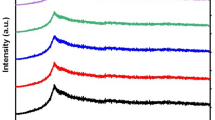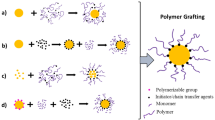Abstract
The polystyrene-based polymer blends, partially miscible poly(bisphenol A carbonate)/polystyrene (PC/PS) and completely miscible poly(2,6-dimethylphenylene oxide)/polystyrene (PPO/PS), in nanorods with gradient composition distribution were discussed. The polymer blend nanorods were prepared by infiltrating the polymer blends into nanopores of anodic aluminum oxide (AAO) templates via capillary action. Their morphology was investigated by micro-Fourier transform infrared spectroscopy (micro-FTIR) and nano-thermal analysis (nano-TA) with spatial resolution. The composition gradient of polymer blends in the nanopores is governed by the difference of viscosity and miscibility between the two polymers in the blends and the pore diameter. The capillary wetting of porous AAO templates by polymer blends offers a unique method to fabricate functional nanostructured materials with gradient composition distribution for the potential application to nanodevices.
Similar content being viewed by others
References
Martin CR. Nanomaterials: A membrane-based synthetic approach. Science, 1994, 266: 1961–1966
Steinhart M. Supramolecular organization of polymeric materials in nanoporous hard templates. Adv Polym Sci, 2008, 220: 123–187
Shin K, Xiang HQ, Moon SI, Kim T, McCarthy TJ, Russell TP. Curving and frustrating flatland. Science, 2004, 306: 76–76
Xiang HQ, Shin K, Kim T, Moon SI, McCarthy TJ, Russell TP. Block copolymers under cylindrical confinement. Macromolecules, 2004, 37: 5660–5664
Sun YM, Steinhart M, Zschech D, Adhikari R, Michler GH, Gösele U. Diameter-dependence of the morphology of PS-b-PMMA nanorods confined within ordered porous alumina templates. Macromol Rapid Commun, 2005, 26: 369–375
Dobriyal P, Xiang H, Kazuyuki M, Chen J-T, Jinnai H, Russell TP. Cylindrically confined diblock copolymers. Macromolecules, 2009, 42: 9082–9088
Woo E, Huh J, Jeong YG, Shin K. From homogeneous to heterogeneous nucleation of chain molecules under nanoscopic cylindrical confinement. Phys Rev Lett, 2007, 98: 136103
Duran H, Steinhart M, Butt HJ, Floudas G. From heterogeneous to homogeneous nucleation of isotactic poly(propylene) confined to nanoporous alumina. Nano Lett, 2011, 11: 1671–1675
Steinhart M, Göring P, Dernaika H, Prabhukaran M, Gösele U, Hempel E, Thurn-Albrecht T. Coherent kinetic control over crystal orientation in macroscopic ensembles of polymer nanorods and nanotubes. Phys Rev Lett, 2006, 97: 027801
Wu H, Wang W, Yang H, Su Z. Crystallization and orientation of syndiotactic polystyrene in nanorods. Macromolecules, 2007, 40: 4244–4249
Steinhart M, Senz S, Wehrspohn RB, Gösele U, Wendorff JH. Curvature-directed crystallization of poly(vinylidene difluoride) in nanotube walls. Macromolecules, 2003, 36: 3646–3651
Shin K, Woo E, Jeong YG, Kim C, Huh J, Kim KW. Crystalline structures, melting, and crystallization of linear polyethylene in cylindrical nanopores. Macromolecules, 2007, 40: 6617–6623
Wu H, Wang W, Huang Y, Su Z. Orientation of syndiotactic polystyrene crystallized in cylindrical nanopores. Macromol Rapid Commun, 2009, 30: 194–198
Wu H, Wang W, Su ZH. Crystallization and orientation of polyethelene in anodic aluminum oxide templates. Acta Polym Sin, 2009, 425–429
Martin J, Mijangos C, Sanz A, Ezquerra TA, Nogales A. Segmental dynamics of semicrystalline poly(vinylidene fluoride) nanorods. Macromolecules, 2009, 42: 5395–5401
Lutkenhaus JL, McEnnis K, Serghei A, Russell TP. Confinement effects on crystallization and curie transitions of poly(vinylidene fluoride-co-trifluoroethylene). Macromolecules, 2010, 43: 3844–3850
Shin K, Obukhov S, Chen JT, Huh J, Hwang Y, Mok S, Dobriyal P, Thiyagarajan P, Russell TP. Enhanced mobility of confined polymers. Nat Mater, 2007, 6: 961–965
Martin J, Krutyeva M, Monkenbusch M, Arbe A, Allgaier J, Radulescu A, Falus P, Maiz J, Mijangos C, Colmenero J, Richter D. Direct observation of confined single chain dynamics by neutron scattering. Phys Rev Lett, 2010, 104: 197801
Serghei A, Chen D, Lee DH, Russell TP. Segmental dynamics of polymers during capillary flow into nanopores. Soft Matter, 2010, 6: 1111–1113
Wu H, Wang W, Huang Y, Wang C, Su Z. Polymorphic behavior of syndiotactic polystyrene crystallized in cylindrical nanopores. Macromolecules, 2008, 41: 7755–7758
Zhang MF, Dobriyal P, Chen JT, Russell TP, Olmo J, Merry A. Wetting transition in cylindrical alumina nanopores with polymer melts. Nano Lett, 2006, 6: 1075–1079
Wu H, Su Z, Takahara A. Molecular composition distribution of polycarbonate/ polystyrene blends in cylindrical nanopores. Polym J, 2011, 43: 600–605
Wu H, Su Z, Takahara A. Gradient composition distribution in poly(2,6-dimethylphenylene oxide)/polystyrene blend nanorods. Soft Matter, 2011, 7: 1868–1873
Martin J, Mijangos C. Tailored polymer-based nanofibers and nanotubes by means of different infiltration methods into alumina nanopores. Langmuir, 2009, 25: 1181–1187
Garcia-Gutierrez MC, Linares A, Hernandez JJ, Rueda DR, Ezquerra TA, Poza P, Davies RJ. Confinement-induced one-dimensional ferroelectric polymer arrays. Nano Lett, 2010, 10: 1472–1476
Chen D, Chen JT, Glogowski E, Emrick T, Russell TP. Thin film instabilities in blends under cylindrical confinement. Macromol Rapid Commun, 2009, 30: 377–383
Ai SF, Lu G, He Q, Li JB. Highly flexible polyelectrolyte nanotubes. J Am Chem Soc, 2003, 125: 11140–11141
Azzaroni O, Lau KHA. Layer-by-layer assemblies in nanoporous templates: nano-organized design and applications of soft nanotechnology. Soft Matter, 2011, 7: 8709–8724
Cepak VM, Martin CR. Preparation of polymeric micro- and nanostructures using a template-based deposition method. Chem Mater, 1999, 11: 1363–1367
Zheng RK, Chan HLW, Choy CL. A simple template-based hot-press method for the fabrication of metal and polymer nanowires and nanotubes. Nanotechnology, 2005, 16: 1928–1934
Kimura T, Kobayashi M, Morita M, Takahara A. Preparation of poly(vinylidene fluoride-co-trifluoroethylene) film with a hydrophilic surface by direct surface-initiated atom transfer radical polymerization without pretreatment. Chem Lett, 2009, 38: 446–447
Quiram DJ, Register RA, Marchand GR, Adamson DH. Chain orientation in block copolymers exhibiting cylindrically confined crystallization. Macromolecules, 1998, 31: 4891–4898
Huang P, Zhu L, Cheng SZD, Ge Q, Quirk RP, Thomas EL, Lotz B, Hsiao BS, Liu LZ, Yeh FJ. Crystal orientation changes in two-dimensionally confined nanocylinders in a poly(ethylene oxide)-b-polystyrene/polystyrene blend. Macromolecules, 2001, 34: 6649–6657
Sun L, Zhu L, Ge Q, Quirk RP, Xue CC, Cheng SZD, Hsiao BS, Avila-Orta CA, Sics I, Cantino ME. Comparison of crystallization kinetics in various nanoconfined geometries. Polymer, 2004, 45: 2931–2939
Huang P, Guo Y, Quirk RP, Ruan JJ, Lotz B, Thomas EL, Hsiao BS, Avila-Orta CA, Sics I, Cheng SZD. Comparison of poly(ethylene oxide) crystal orientations and crystallization behaviors in nano-confined cylinders constructed by a poly(ethylene oxide)-b-polystyrene diblock copolymer and a blend of poly(ethylene oxide)-b-polystyrene and polystyrene. Polymer, 2006, 47: 5457–5466
Nojima S, Ohguma Y, Kadena K, Ishizone T, Iwasaki Y, Yamaguchi K. Crystal orientation of poly(ɛ-caprolactone) homopolymers confined in cylindrical nanodomains. Macromolecules, 2010, 43: 3916–3923
Chung TM, Wang TC, Ho RM, Sun YS, Ko BT. Polymeric crystallization under nanoscale 2d spatial confinement. Macromolecules, 2010, 43: 6237–6240
Li D, Xia YN. Electrospinning of nanofibers: Reinventing the wheel? Adv Mater, 2004, 16: 1151–1170
Liu Y, Cui L, Guan FX, Gao Y, Hedin NE, Zhu L, Fong H. Crystalline morphology and polymorphic phase transitions in electrospun nylon-6 nanofibers. Macromolecules, 2007, 40: 6283–6290
Zhang CF, Liu YH, Liu SX, Li HZ, Huang K, Pan QH, Hua XH, Hao CW, Ma QF, Lv CY, Li WH, Yang ZL, Zhao Y, Wang DJ, Lai GQ, Jiang JX, Xu YZ, Wu JG. Crystalline behaviors and phase transition during the manufacture of fine denier PA6 fibers. Sci China Chem, 2009, 52: 1835–1842
Yano T, Yah WO, Yamaguchi H, Terayama Y, Nishihara M, Kobayashi M, Takahara A. Preparation and surface characterization of surface-modified electrospun poly(methyl methacrylate) copolymer nanofibers. Chem Lett, 2010, 39: 1110–1111
Zhang H, Zhao CG, Zhao YH, Tang GW, Yuan XY. Electrospinning of ultrafine core/shell fibers for biomedical applications. Sci China Chem, 2010, 53: 1246–1254
Suh KY, Kim YS, Lee HH. Capillary force lithography. Adv Mater, 2001, 13: 1386–1389
Hu ZJ, Jonas AM. Control of crystal orientation in soft nanostructures by nanoimprint lithography. Soft Matter, 2010, 6: 21–28
Honda K, Morita M, Masunaga H, Sasaki S, Takata M, Takahara A. Room-temperature nanoimprint lithography for crystalline poly (fluoroalkyl acrylate) thin films. Soft Matter, 2010, 6: 870–875
He XH, Song M, Liang HJ, Pan CY. Self-assembly of the symmetric diblock copolymer in a confined state: Monte Carlo simulation. J Chem Phys, 2001, 114: 10510–10513
Li WH, Wickham RA, Garbary RA. Phase diagram for a diblock copolymer melt under cylindrical confinement. Macromolecules, 2006, 39: 806–811
Zhu YT, Jiang W. Self-assembly of diblock copolymer mixtures in confined states: a Monte Carlo study. Macromolecules, 2007, 40: 2872–2881
Yu B, Li BH, Jin QH, Ding DT, Shi AC. Confined self-assembly of cylinder-forming diblock copolymers: Effects of confining geometries. Soft Matter, 2011, 7: 10227–10240
Ma Y, Hu WB, Hobbs J, Reiter G. Understanding crystal orientation in quasi-one-dimensional polymer systems. Soft Matter, 2008, 4: 540–543
Xiao XQ, Huang YM, Feng JA, Liu HL, Hu Y. Microphase separation of a diblock copolymer dispersed in nanorod arrays grafted on a plate: a Monte Carlo study. Macromol Theory Simul, 2011, 20: 124–132
Utracki LA. Polymer Alloys and Blends. New York: Hanser Publ., 1989
Agari Y, Shimada M, Ueda A, Nagai S. Preparation, characterization and properties of gradient polymer blends: discussion of poly(vinyl chloride)/poly(methyl methacrylate) blend films containing a wide compositional gradient phase. Macromol Chem Phys, 1996, 197: 2017–2033
Patterson D, Robard A. Thermodynamics of polymer compatibility. Macromolecules, 1978, 11: 690–695
Kim WN, Burns CM. Thermal-behavior, morphology, and the determination of the Flory-Huggins interaction parameter of polycarbonate polystyrene blends. J Appl Polym Sci, 1987, 34: 945–967
Fekete E, Foldes E, Damsits F, Pukanszky B. Interaction-structure-property relationships in amorphous polymer blends. Polym Bull, 2000, 44: 363–370
Masuda H, Fukuda K. Ordered metal nanohole arrays made by a two-step replication of honeycomb structures of anodic alumina. Science, 1995, 268: 1466–1468
Li AP, Muller F, Birner A, Nielsch K, Gösele U. Hexagonal pore arrays with a 50–420 nm interpore distance formed by self-organization in anodic alumina. J Appl Phys, 1998, 84: 6023–6026
Lee SN, Stolarski V, Letton A, Laane J. Studies of bisphenol-A-polycarbonate aging by Raman difference spectroscopy. J Mol Struct, 2000, 521: 19–23
Liang CY, Krimm S. Infrared spectra of high polymers. VI. Polystyrene. J Polym Sci, 1958, 27: 241–254
Kong XM, Xie XM, Yang R, Wang KH, Zhang ZM, Lei H. Determination of the composition distribution of polymer blend films by using microscopic FTIR. Spectrosc Spect Anal, 2000, 20: 623–625
Nakashima K, Ren Y, Nishioka T, Tsubahara N, Noda I, Ozaki Y. Two-dimensional infrared correlation spectroscopy studies of polymer blends: conformational changes and specific interactions in blends of atactic polystyrene and poly(2,6-dimethyl-1,4-phenylene ether). J Phys Chem B, 1999, 103: 6704–6712
Wellinghoff ST, Koenig JL, Baer E. Spectroscopic examination of chain conformation and bonding in poly(phenylene oxide)-polysty-rene blends. J Polym Sci, Part B: Polym Phys, 1977, 15: 1913–1925
Yang FZ, Wornyo E, Gall K, King WP. Thermomechanical formation and recovery of nanoindents in a shape memory polymer studied using a heated tip. Scanning, 2008, 30: 197–202
Maruf SH, Ahn DU, Greenberg AR, Ding Y. Glass transition behaviors of interfacially polymerized polyamide barrier layers on thin film composite membranes via nano-thermal analysis. Polymer, 2011, 52: 2643–2649
Zhu S, Liu Y, Rafailovich MH, Sokolov J, Gersappe D, Winesett DA, Ade H. Confinement-induced miscibility in polymer blends. Nature, 1999, 400: 49–51
Liu CY, Zhang BQ, He JS, Keunings R, Bailly C. Confinement effects on chain and glass dynamics in immiscible polymer blends. Macromolecules, 2009, 42: 7982–7985
Lomellini P. Viscosity-temperature relationships of a polycarbonate melt: williams-landel-ferry versus arrhenius behavior. Makromol Chem, 1992, 193: 69–79
Fox TG, Flory PJ. The glass temperature and related properties of polystyrene. Influence of molecular weight. J Polym Sci, 1954, 14: 315–319
Author information
Authors and Affiliations
Corresponding author
Rights and permissions
About this article
Cite this article
Wu, H., Su, Z., Terayama, Y. et al. Polystyrene-based blend nanorods with gradient composition distribution. Sci. China Chem. 55, 726–734 (2012). https://doi.org/10.1007/s11426-012-4501-5
Received:
Accepted:
Published:
Issue Date:
DOI: https://doi.org/10.1007/s11426-012-4501-5




